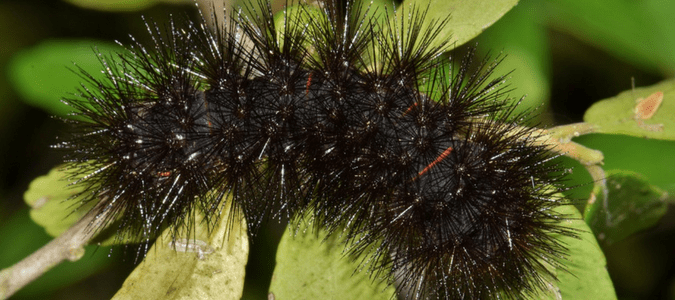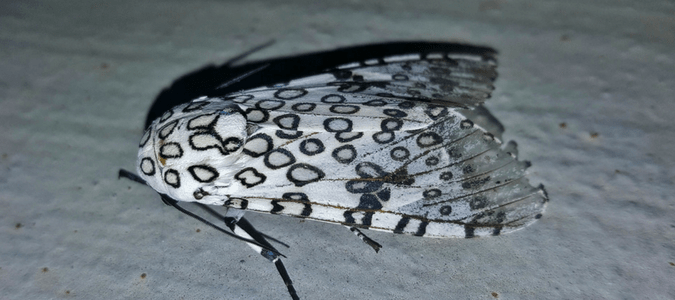
You’ve probably seen one at some point–a black spiky caterpillar with red stripes. Those fuzzy little creatures can be quite intimidating if you don’t know much about them. You have probably stayed away because you were worried about these fuzzy creatures being poisonous.
Worry no more–the giant leopard moth caterpillar is just looking for a quiet space to get ready to turn into a beautiful white moth with black circular designs, creating a leopard-like pattern. This type of caterpillar is both harmless and beautiful to look at, which makes them a welcome visitor to your outdoor spaces.
What Will I Learn?
- What is That Red and Black Caterpillar?
- Are Fuzzy Caterpillars Poisonous?
- Giant Leopard Moth
- How to Attract Caterpillars to Your Yard
- Get Professional Help to Attract Caterpillars
What Is That Red And Black Caterpillar?
Also called an eyed-tiger moth caterpillar or commonly a “woolly bear”, this type of caterpillar has black spikes all over its body, giving it a fuzzy look. It has red or orange bands spread over the fuzz, making it look a bit like a black bear with belts on it. And when it’s disturbed, the fuzzy caterpillar rolls into a ball, where the red bands are even more prominent so that they can ward off potential predators. There may be a little yellow liquid on your hand if you pick one up; it’s a defense mechanism. While the liquid does not bother your hand, you don’t want to ingest it, so wash your hands after you’ve touched one of these hairy creatures.
Not all giant leopard moth caterpillars look big and fuzzy; they go through several stages of molting before they fully develop their spikes and then go on to become beautiful moths. When younger, these caterpillars can be brown or black and have a few noticeable bands. Their molting cycle is fascinating to watch, as each molt brings out more spikes and more bands, allowing you to monitor their growth.
All caterpillars eventually turn into moths, and the giant leopard moth is particularly striking. Its three-inch white wings look almost porcelain, with embossed black rings randomly positioned throughout. It’s bright and unique, making it stand out even among the most eye-catching insects.
Are Fuzzy Caterpillars Poisonous?
Hairless caterpillars are harmless, and most of the fuzzy caterpillars are harmless as well, just like the giant leopard moth caterpillar. Looks can be quite deceiving, however. Even those species that look like they would be poisonous are not necessarily; for instance, the tomato hornworm and the hickory horned devil are not.
The most common poisonous caterpillar is the saddle-back. This caterpillar is bright green with a circular brown patch in the center of its back with stiff white bristles on either end of the body. The puss caterpillar is also poisonous. It is covered in soft brown fur and is about the size of a quarter. The bristles can leave you with a burning sensation and cause immediate swelling where it touched you.
Other poisonous caterpillars include the bag caterpillar, cinnabar moth caterpillar, the appropriately-named stinging rose caterpillar and the monarch caterpillar. This is by no means an exhaustive list, so if you’re concerned about whether a caterpillar is poisonous, your best bet is to avoid it.

Giant Leopard Moth
Through a process of metamorphosis, the Eyed Tiger Moth Caterpillar transforms into the Giant Leopard Moth! Since caterpillars, like humans, are diurnal, we often see these creatures more than we see the moths they become. The nocturnal giant leopard moth has a wingspan that’s around three inches and distinctive black circles on its wings. These moths have a bluish-black hue with some orange areas. You might notice an adult leopard (or tiger) moth near your porch light during the early summer months, up until fall. When a predator is nearby, giant leopard moths “play dead” by curling up to show their brightly-colored abdomen. One interesting part of the moth’s biology is that it has ears to protect itself against hunting bats.
How To Attract Caterpillars To Your Yard
Having caterpillars, moths and butterflies in your garden or yard adds life and a sense of calm, just as having a variety of birds around can. Caterpillars, moths and butterflies are an important part of our ecosystem, providing food for a variety of other creatures, like bats and birds, and they help pollinate flowers by drinking their nectar and promoting seed production.
Caterpillars, moths and butterflies are as important as bees in helping determine the health of your yard’s ecosystem. They are sensitive to changes in their environment, so monitoring how many you have can be an important guide to where you need to adjust your fertilizer, lawn or garden food and weed control.
If you’re interested in attracting the giant leopard moth caterpillar to your yard, here are some of the best plants:
- Angel trumpet
- Basil
- Bougainvillea
- Brassica
- Cabbage
- Citrus
- Empress tree
- Honeysuckles
- Lettuce
- Lilacs
- Magnolia
- Mulberry tree
- Sunflowers
- Willows
Trust Your Lawn to ABC
At ABC Home & Commercial Services, we are experts at ensuring your yard is healthy, with just the right yard and garden supplements to both attract the right kind of wildlife and keep the unhealthy kind away. Rely on our lawn specialists to diagnose and treat any lawn problems and to suggest new additions to your landscape to enhance your home’s exterior. Schedule a service today.
